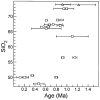| Journal of Petrology | Pages |
© 1998 Oxford University Press |
Most studies of ocean island magmatism have focused on basaltic rocks and used incompatible element and isotope characteristics to define the composition(s) and melting behavior of the mantle source(s). Felsic volcanism on ocean islands is typically interpreted as the product of fractional crystallization of mafic magmas derived from hotspot-related plume sources (e.g. le Roex, 1985; Storey et al., 1989), although recent detailed studies have called attention to open-system processes that may modify incompatible element and radiogenic isotopic ratios (e.g. Bohrson & Reid, 1995,, 1998; Thirlwall et al., 1997). Volumetrically, the occurrence of differentiated compositions in ocean island settings perhaps is under-appreciated, so understanding differentiation processes is particularly important as it will (1) determine the extent to which care must be taken in using isotope and incompatible trace element ratios indiscriminately to characterize mantle sources, and (2) define the time scales over which mass and heat are delivered from the mantle at ocean islands. The felsic rocks of Ascension have long been known to be characterized by unusually high 87Sr/86Sr. This feature has been variously ascribed as the result of incorporation of pelagic sediment (Harris et al., 1982) or altered oceanic crust (Weis et al., 1987), or subsolidus alteration by seawater (Sheppard & Harris, 1985). Here we show that the felsic rocks of Ascension are largely derived by closed-system fractional crystallization, and that the Sr isotope characteristics, in most cases, reflect weathering and hydrothermal alteration of extremely low Sr rocks. Ascension Island (7°56'S, 14°22'W) in the South Atlantic Ocean (Fig. 1), is a hotspot-related intra-plate volcanic island (Brozena, 1986). The edifice is constructed on 5-6-my-old oceanic lithosphere to the west of the Mid Atlantic Ridge, with ~1% of its volume exposed above sea level (Harris, 1983). Trachyte and rhyolite compose ~14% of the surface exposure (Nielson & Sibbett, 1996) of lava flows and pyroclastic deposits. Pyroclastic (scoria and pumice) deposits make up ~43% of the island's total areal extent (Atkins et al., 1964; Harris, 1983). Also present are plutonic (granite, syenite, and monzonite) xenoliths which represent fractionation products of felsic magmas. Most of the felsic volcanic rocks and plutonic xenoliths have high initial 87Sr/86Sr compared with the mafic rocks on the island. The present study is directed to understand the petrogenesis of the felsic (>60% SiO2) rocks and the cause of high 87Sr/86Sr in these felsic volcanic and plutonic rocks from Ascension. A more detailed consideration of the interactions involved during differentiation will be presented elsewhere. Figure
Ascension is a composite volcano with >50 scoria cones scattered over the island. The exposed volcanic rocks comprise transitional to mildly alkaline basalt-hawaiite-mugearite-benmoreite-trachyte-rhyolite series [by the Le Bas et al., (1986) classification] lava flows, trachytic domes, scoria cones, and pyroclastic deposits (Fig. 1). Before this study, the pyroclastic deposits of mafic and felsic composition have been largely uncharacterized. In this study we geochemically and petrogenetically characterize the voluminous pumice deposits, trachyte domes, felsic lava flows, and plutonic and volcanic xenoliths. There are two distinctive felsic eruptive centers on the island, the central felsic complex and the eastern felsic complex. The central felsic complex comprises the Middleton Ridge felsic center and Green Mountain (Fig. 1). Middleton Ridge is composed primarily of trachyte flows and pumice, and some rhyolite and rhyolitic obsidian. The highest peak on the island, Green Mountain (859 m), is made up of massive, thick pyroclastic (mostly pumice) fall deposits with the southwestern flanks mostly constituted of trachyte. The eastern felsic complex is made up of numerous trachyte flows and lava domes (Fig. 1). A voluminous trachyte lava flow originated from Devil's Cauldron and flowed northward and eastward. Devil's Cauldron is interpreted to be an explosion crater with the trachyte dome of Weather Post adjacent. Southeast of Devil's Cauldron and Weather Post is the trachytic flow dome of White Horse, to the east of which is the comenditic coulée of Little White Hill (Fig. 1). At the extreme eastern end of the island, South East Head is constituted of trachyte. In the southeastern part of Ascension small trachyte bodies occur at Round Hill, Cocoanut Bay, Ragged Hill, and Pillar Bay (Fig. 1). Trachyte from Ragged Hill and Cocoanut Bay contains unusually high modal abundance of alkali feldsparphenocrysts. In the western part of the island trachyte is found locally at Devil's Riding School, Daly's Crags, and Cross Hill (Fig. 1). Rhyolitic compositions are relatively rare, being restricted to the rhyolite flow on Middleton Ridge in the central felsic complex, Little White Hill, and a flow in the cliff section to the north of White Horse in the eastern felsic complex. Felsic plutonic xenoliths (monzonite, syenite, and granite) and volcanic xenoliths (trachyte and rhyolite) occur mainly in pyroclastic deposits on the western flanks of Green Mountain. The granite, syenite, and monzonite xenoliths have been described in great detail by Roedder & Coombs, (1967),Harris & Bell, (1982),Harris et al., (1982),Harris, (1983),Sheppard & Harris, (1985), and Harris & Sheppard, (1987). The granite xenoliths from Five Mile Post vary in size from a few centimeters to 25-30 cm in length; most are fine grained. Monzonite xenoliths occur on Middleton Ridge in pumice deposits and syenite xenoliths occur in the mugearite and benmoreite lava flows from Broken Tooth (Harris, 1983). Trachytic and rhyolitic xenoliths from close to Five Mile Post vary in size from a few centimeters to ~30 cm and have a laminated fabric. A limited number of age dates (K-Ar) for Ascension trachyte and rhyolite exist in the literature (Harris et al., 1982; Nielson & Sibbett, 1996); we have added four new Ar-Ar age dates on feldspar phenocrysts. There is a distinct clustering of ages among the exposed rocks on the island (Fig. 2), with the higher SiO2 rocks being significantly older (range from 1·2 to 0·56 Ma) thanthe mafic volcanic rocks (range from 0·47 to 0·12 Ma,with a basaltic dike from Middleton Ridge dated at0·80 Ma). Figure
The first phase of felsic volcanism occurred in the central part of the island. A rhyolite east of Middleton Ridge is dated at 0·99 ± 0·02 Ma; this is overlain by a trachyte flow with an age of 0·82 ± 0·02 Ma and this flow is overlain by a trachyte dome closely associated with a trachyte lava flow dated at 0·65 ± 0·02 Ma (Nielson & Sibbett, 1996). From field and age relationships we suggest that the build-up of the Middleton Ridge felsic center started ~1 my ago and continued until 0·65 my ago. Felsic magmatism next occurred:
These age dates suggest that the areal exposure of the central and the eastern parts of the island was built up over a period of half a million years, from ~1 Ma to 0·56 Ma. Nielson & Sibbett, (1996) suggested that, as the oldest dated rocks in both the felsic complexes are rhyolite, with time the silica content of erupted felsic magma decreased as a compositionally zoned magma chamber was tapped, and that this chamber was active for >0·4 my. We note that the absence of large-volume eruptions such as caldera-related ignimbrites that are typically associated with large, long-lived magma chambers may mitigate against this possibility. Care was taken to obtain samples which were as fresh as possible; where practicable, the interiors of large blocks were sampled. Major and trace element data were obtained by X-ray fluorescence (XRF) and instrumental neutron activation analysis (INAA) at the University of Oklahoma, as distinguished in Table 1, with additional details given by Weaver et al., (1996). Sr concentrations <10 ppm compare well with more precise isotope dilution determinations. Radiogenic isotope data are given in Table 2. Sr and Pb were analyzed using a peak-hopping routine on a VG Sector mass spectrometer, whereas Nd isotope ratios were determined using a VG Sector 54-30 mass spectrometer operating in static mode. Further details have been given by Davidson et al., (1993). Selected data are presented in Tables 1 and 2, with the full data set available from the first author. Oxygen isotope data were obtained at SMU for whole rocks (Table 2) and two feldspar separates using the ClF3 extraction technique described by Borthwick & Harmon, (1983). Table 1. Representative chemical analyses of felsic rocks from Ascension
Table 2. r, Nd, Pb, and O isotopic data for felsic rocks from Ascension
Trachytic rocks vary from being aphyric to very sparsely porphyritic to strongly porphyritic and mostly are massive. The most abundant phenocryst phase is alkali feldspar, with plagioclase, olivine, clinopyroxene, and titanomagnetite forming the other phenocryst or microphenocryst phases. Weaver et al., (1996) reported trachyte from Ragged Hill and Cocoanut Bay that has unusually high contents of alkali feldspar phenocrysts (25-35%). Feldspar phenocrysts are up to 2 mm, olivine up to 1·5 mm, and titanomagnetite and clinopyroxene are up to 0·5 mm and occur as rare clusters. Plagioclase phenocrysts are rare and tabular in shape, and range up to 2·5 mm. Some trachytic rocks contain small (0·5 mm) rounded crystals of arfvedsonite amphibole. The trachyte groundmass comprises a fine-grained felted mass of feldspar laths ranging between 0·1 and 0·2 mm, and rarely up to 1 mm and exhibiting a patchy, weak flow alignment. Rhyolitic rocks mostly are aphyric to sparsely phyric and in general massive; microphenocrysts are alkali feldspar. Alteration of felsic rocks Present-day Ascension has an arid climate and the felsic volcanic and plutonic rocks have no to little petrographic evidence of alteration; most chemical characteristics are therefore likely to be primary igneous ones. However, despite the apparently pristine nature of the lavas,Davidson et al., (1997) showed that Sr contents and isotopic compositions may have been modified, as discussed below. In contrast, pumice samples clearly are hydrated as indicated by elevated H2O- and loss on ignition (LOI) (Table 1) and by whole-rock [delta]18O that ranges between +6 and +17%o (Kar, 1997). Compared with fresh trachyte samples, most pumice samples have undergone significant loss of Na2O (Fig. 3). The K
2O content of the pyroclastic samples is unchanged but, because of Na2O loss, Na2O + K2O and Na2O/K2O are low in pumice compared with massive trachyte flows and domes (Table 1). In addition to Na2O loss, CaO and MgO are higher in pumice relative to trachyte (Table 1), and the loss of Na2O results in a significant apparent increase in SiO2 in pumice (Table 1). Figure
Chemical homogeneity of the felsic rocks In a number of insINTRODUCTION

GENERAL GEOLOGY OF ASCENSION ISLAND
Plutonic and volcanic xenoliths
Ages of evolved rocks on Ascension Island

SAMPLING AND ANALYTICAL TECHNIQUES

PETROGRAPHY
DISCUSSION
Whole-rock geochemistry
